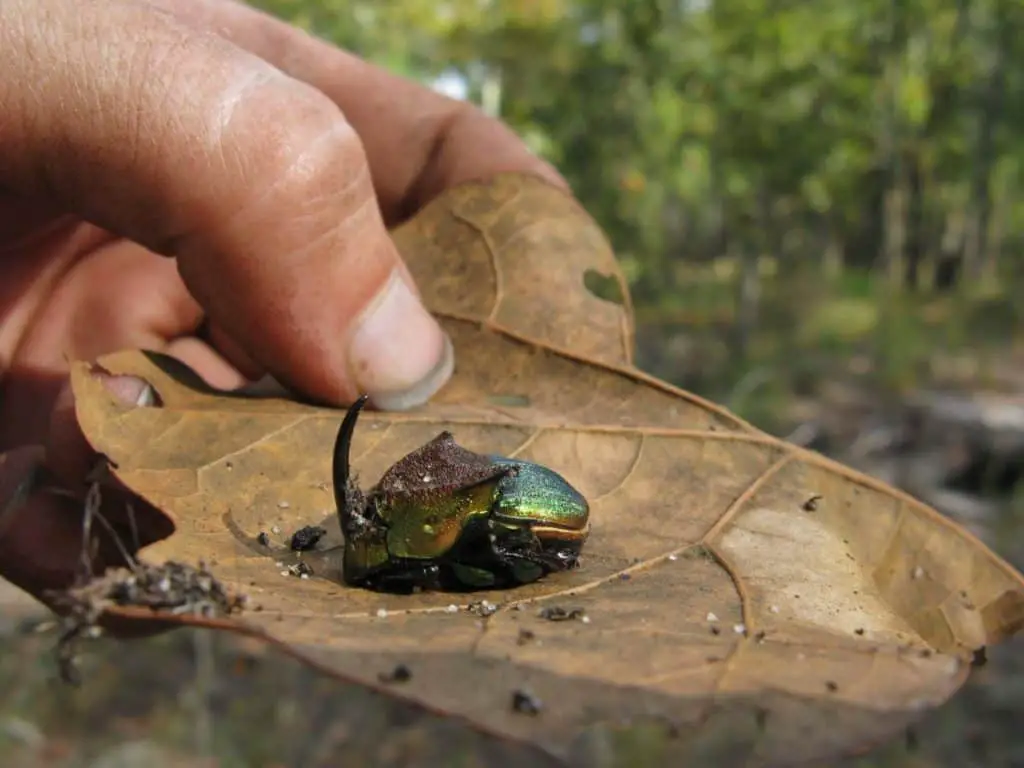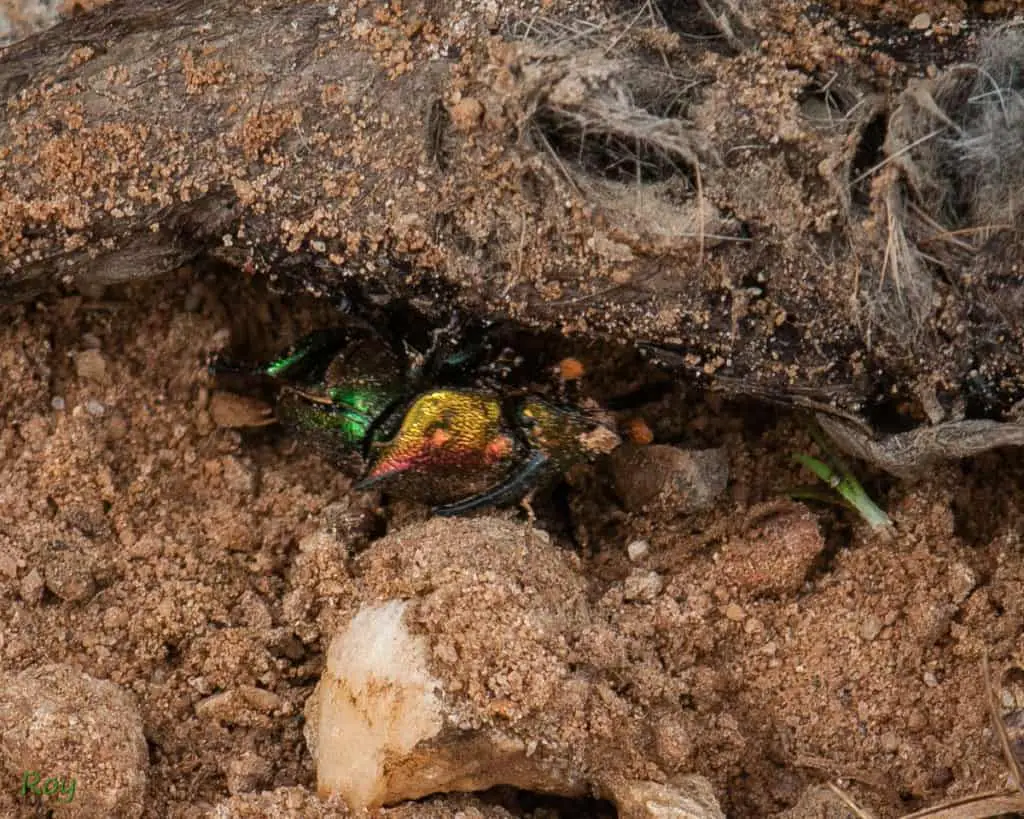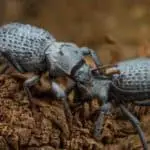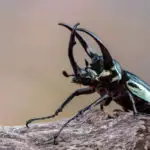Rainbow dung beetles are beautiful creatures with a shiny metallic color. They are great entry-level pets for anyone who wants to start keeping beetles as pets. Here’s a guide to teach you how to keep rainbow dung beetles.
To keep rainbow dung beetles, house them in a tank containing potting soil, organic compost, coco fiber and sand. Feed them with soaked dog biscuits. To breed the beetles, give them 16” deep substrates. Feed them with cow dungs. They lay eggs in dung balls, where the immatures live until they emerge as adults.
Continue reading if you want to know more.
- Basic Introduction to the Rainbow Dung Beetle
- How to Get a Rainbow Dung Beetle
- Housing the Adult Rainbow Dung Beetles
- How to Care for Adult Rainbow Dung Beetles
- How to Breed Rainbow Dung Beetles
- Recommended Supplies
- Handling Rainbow Dung Beetles
- What are the Tiny Creatures on My Rainbow Dung Beetles
- What Kills My Rainbow Dung Beetles
Basic Introduction to the Rainbow Dung Beetle
The rainbow dung beetle or rainbow scarab is known scientifically as the Phanaeus vindex. They can be found in the Eastern United States, all the way to Texas in the south and South Dakota in the north. There is a similar species P. difformis, which is less common.
The adult beetles are about 0.5-1” in length. As implied by its name, the rainbow dung beetles feed on dung, and have distinct metallic colored bodies. Their thorax is generally bronze, while their elytra are generally metallic green in color.

The male rainbow dung beetles have a horn on their head, while female beetles lack one. Certain male, known as the minor male, have a much shorter horn.
Male rainbow dung beetles with bigger horns have more competitive advantages in pairing in the female.
How to Get a Rainbow Dung Beetle
You will be able to get adult rainbow dung beetles from your local pet stores or online stores in the US. Remember to check for their age and look for signs of injury or lost limbs. Alternatively, you can catch the rainbow dung beetles if you are in the Eastern United States.
There are a few ways of catching the rainbow dung beetles. If you are at somewhere with a lot of dung (eg. pasture), you can check out every single dung to look for the beetles. Look for burrows on the ground underneath or next to the dungs. This is where they live and store their eggs.
Alternatively, you can lure the beetles by dung. It seems that human dung works the best. Some people add fermented malt to amplify the odor. Always add the fermented malt to the dung only when you set up the lure in the field. By doing so, if you are careless and forget to ventilate the fermenting malt, at least you need to clear the exploded malt instead of exploded dung…
On a windy day, place the dung on the ground in an open field and spread the dung with a stick to increase its surface. Let the wind spread the odor of the dung around.
The rainbow dung beetles (if they exist in that area) along with other dung beetles and flies will detect the smell and fly towards the dung. You can catch them using a bug catching net when they fly near the dung. This may take some time so it is a good idea to bring a chair and some water (and snacks if you are cool to eat while smelling the dung).
You can also trap the beetles with a simple pitfall trap. Just dig a hole in the ground and put in a bucket. The opening of the bucket should be lower or at the same level as the ground. Put a little bit of dung and some soil at the bottom of the bucket to keep them busy before you manage to collect them. Otherwise they might leave the bucket.
Then, put 2 sticks on the opening and hang the cup with dung on the sticks. This will serve as the main lure. You can add some water to the dung so that it can last longer.
After that, cover the opening with a metal plate or plastic lid at ~25° from the ground. This reduces the chance of escaping while also allowing the beetles to enter through the opening. At the same time it reduces flooding due to rain and provides a shaded place for the beetles to party.
Lastly, surround your trap with chicken wire to prevent other animals from disturbing your traps. You should check your trap at least daily to retrieve live beetles.
Housing the Adult Rainbow Dung Beetles
The rainbow dung beetles can be housed in a small fish tank. Fill the tank with 6-8” of substrates consisting of potting soil, organic compost, coco fiber and sand in 3:3:3:1 ratio. These beetles stay in the burrow. Hence, you can increase the depth of substrates to give them more space to build their burrows.
If you plan to breed them, you need a deeper tank and make the substrate 16” in depth. Mist the substrates with some water to make it moist but not wet.
Cover the housing with a lid. This prevents the beetles from escaping, while to a certain extent containing the odor in the housing. Make sure the housing is well ventilated and keep it away from direct sunlight at 70-77 °F (~21-25 °C).
How to Care for Adult Rainbow Dung Beetles
While the beetles prefer dung, you can feed them with dog biscuit. Simply soak some dog biscuits until they are expanded. Then, put the biscuits on a small plate to feed the beetles. The beetles can survive well without dung.
If you are willing to use dung, you can buy some dried, non-composted dung. Make sure the dungs do not contain any pesticides and are maggot-free. Some growers feed their livestock with insect growth regulators so that their dungs kill the fly maggots. Just wet the dung and offer it to you beetles.
If you have other pets at home, you can also try feeding your rainbow dung beetles with their droppings. There are hobbyists who feed their dung beetles with rabbit and tortoise dung (and even human’s dung).
The dung beetles typically move the food into their burrows. They might not be able to finish all the food they have collected within the same day. Hence, sometimes they don’t turn up to collect the food offered. You should replace any uncollected food every 2-3 days to prevent growth of mold.
Add some water to the substrates to make it moist. You want to be able to press the substrates in your palms to make them hold briefly into a shape. But there shouldn’t be any water seeping out.
Rainbow dung beetles typically live for 6-12 months in captivity. However, it is hard to estimate their age because most beetles are caught as adults.
Note that they are known to overwinter.
How to Breed Rainbow Dung Beetles

To breed the rainbow dung beetles, you need to provide them with cow or human dung. Not many people are ready to do that.
In general, rainbow dung beetles prefer dungs of omnivores better than those of herbivores, followed by carnivores.
Because most rainbow dung beetles are collected from the field as adult beetles, some of the female beetles may have mated. They can lay eggs even if you don’t have a male beetle. At the same time, some of them might be too old to breed. The safest bet is to get more beetles (including male) if you want to breed them.
The rainbow dung beetles create dung balls from dung and soil, in which they lay their eggs. They keep the dung balls in the burrows. On top of that, the beetles will create another tunnel in which they store a few more dung balls without eggs. These dung balls serve as food reserves for their offspring when they turn into adults.
The hatched grub grows within the dung ball and feeds on it. It stays there until it pupates and emerges into an adult.
Recommended Supplies
Here’s my recommended supplies that you can consider getting for your rainbow dung beetles. Note that I get a small commission when you buy the items through the links in this page. This helps me to maintain the site without incurring additional costs to you.
Handling Rainbow Dung Beetles
While the adult beetles are protected with a thick layer of armor, you should be gentle when handling them. Always grab their thorax instead of their legs. Their legs are fragile and have spines that might hurt you.
Try not to disturb the substrates too much, especially if you intend to breed them. The rainbow dung beetles need to spend a lot of time and energy to build the dung balls. Digging up the substrates might damage the dung balls along with the eggs.
The rainbow dung beetles may play dead if disturbed. Don’t be shocked if they seem like they are dead when you handle or catch them. Wait for a few minutes and you should see them gone live again.
Note that the rainbow dung beetles are good fliers. Be careful when handling them so that they don’t fly away.
What are the Tiny Creatures on My Rainbow Dung Beetles
The rainbow dung beetles may carry some very tiny creatures on their body when you catch/buy them. Those are most likely Macrocheles amygdaligera, a species of predatory mites.
It sounds dangerous to have a predatory mite, but it is not. The mites feed on the eggs and larvae of other insects but do no harm to the rainbow dung beetles. They rely on the beetles to transport them from dung to dung so that they can look for new sources of food.
If you are keeping other insects, it is best to remove those mites though. You can use a small brush to brush the mites off your rainbow dung beetles before bringing the beetles home.
What Kills My Rainbow Dung Beetles
There are 2 things that may kill your rainbow dung beetles. Pay attention to:
Substrate and dung– make sure the substrate and food you use are pesticide-free and fertilizer-free. In the case of dung, make sure you use dungs that are not treated with pesticides, or the animals producing the dung are not fed with insecticides. Some livestock are fed with insect growth regulators or other insecticides which accumulate in their dung to kill any insects trying to breed in the dung. Beetles are insects, so yeah, they will be killed as well.
Moisture – moisture is very crucial for the beetles. They will not survive without adequate moisture. At the same time, too much moisture will hinder their breathing and promote growth of mold, which can kill them.


